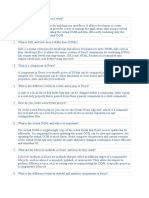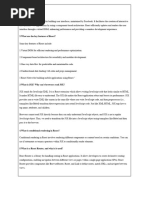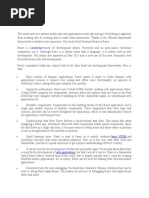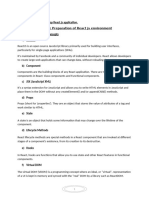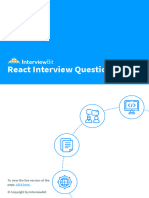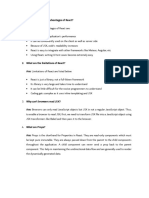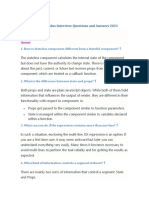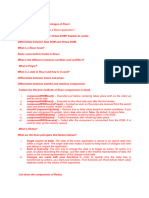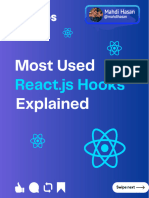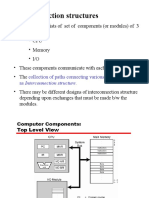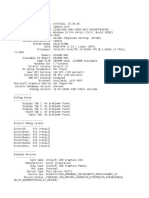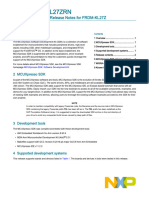0 ratings0% found this document useful (0 votes)
5 viewsreact(1)
react(1)
Uploaded by
vishallengare61Copyright:
© All Rights Reserved
Available Formats
Download as TXT, PDF, TXT or read online from Scribd
react(1)
react(1)
Uploaded by
vishallengare610 ratings0% found this document useful (0 votes)
5 views2 pagesCopyright
© © All Rights Reserved
Available Formats
TXT, PDF, TXT or read online from Scribd
Share this document
Did you find this document useful?
Is this content inappropriate?
Copyright:
© All Rights Reserved
Available Formats
Download as TXT, PDF, TXT or read online from Scribd
Download as txt, pdf, or txt
0 ratings0% found this document useful (0 votes)
5 views2 pagesreact(1)
react(1)
Uploaded by
vishallengare61Copyright:
© All Rights Reserved
Available Formats
Download as TXT, PDF, TXT or read online from Scribd
Download as txt, pdf, or txt
You are on page 1of 2
1. What is React? Why use it?
React is a JavaScript library for building user interfaces, especially single-page
apps. It helps create fast and interactive UIs with components.
2. What is the virtual DOM?
The virtual DOM is a lightweight copy of the real DOM. React uses it to update only
the parts of the UI that changed, making updates faster.
3. What are components in React?
Components are building blocks of a React app. They are reusable pieces of UI like
buttons or forms.
4. Difference between functional and class components?
Functional components are simple JavaScript functions used in later versions of
React. Class components use ES6 classes and have access to lifecycle methods, and
were generally more common before React 16.8
5. What are props? How are they different from state?
Props are inputs passed to components from parent components. State is internal
data that can change within a component.
6. What is JSX? Can browsers read it?
JSX is a syntax extension of JavaScript that looks like HTML. Browsers can’t read
JSX directly; it needs to be compiled to regular JavaScript.
7. What is state in React?
State is a special object used to hold data that can change over time and re-render
the component when updated.
8. What are React hooks?
Hooks let you use state and other React features in functional components.
Examples: useState, useEffect.
9. What are the rules of hooks?
Hooks must be called at the top level of functional components and only in React
functions (not in loops or conditionals).
10. What is useState?
useState is a hook that lets you add state to functional components. Example: const
[count, setCount] = useState(0);
11. What is useEffect?
useEffect is a hook for performing side effects (like data fetching) after
rendering. It runs after the component mounts or updates.
12. What is useContext?
useContext allows you to share data between components without prop drilling
(passing props down multiple levels).
14. What is useRef?
useRef creates a reference to a DOM element or a value that persists across renders
but doesn’t cause re-rendering when changed.
15. What is React.memo?
React.memo is a higher-order component that prevents unnecessary re-renders if the
props haven't changed.
16. What is lazy loading in React?
Lazy loading delays loading components until they are needed (e.g., when the user
scrolls to them). Use React.lazy() and Suspense for this.
17. What is the Context API?
Context API allows you to share state globally across components without passing
props manually at every level.
18. What is the difference between Redux and Context API?
Redux is more powerful for large apps with complex state, while Context API is
simpler but suitable for smaller apps or specific use cases.
19. How do you handle events in React?
React handles events similarly to HTML but uses camelCase syntax (e.g., onClick
instead of onclick). Events in React are synthetic events, a wrapper around browser
events for consistency across browsers.
20. What are controlled and uncontrolled components?
Controlled components are form elements where React manages the state. In
uncontrolled components, the DOM manages its own state.
21. What is an error boundary?
An error boundary is a React component that catches JavaScript errors in its child
components and displays a fallback UI instead of crashing the app.
22. What are higher-order components (HOCs)?
A HOC is a function that takes a component and returns a new component with added
features (e.g., handling authentication).
23. How do you optimize a React app?
Common optimizations include memoization (e.g., using React.memo), lazy loading,
code splitting, and using the useCallback and useMemo hooks to prevent unnecessary
re-renders. generally these techniques applicable only in older version of react
because in later version we don`t have to implement these features react will
automatically take care it
24. What is React Router?
React Router is a library for handling navigation and routing in React apps. It
allows for multiple views in a single-page app.
25. What is SSR (Server-Side Rendering)?
SSR is when HTML is rendered on the server and sent to the client. This improves
SEO and load time compared to client-side rendering.
26. What is React Fiber?
React Fiber is a new algorithm in React 16+ that makes rendering more efficient and
allows React to pause and resume rendering work.
27. How does the virtual DOM improve performance?
The virtual DOM allows React to make updates faster by comparing the previous
virtual DOM with the new one and updating only the necessary parts of the actual
DOM.
You might also like
- SN IND 1 011 - InteractionLayerDocument10 pagesSN IND 1 011 - InteractionLayerVishnu R Nair100% (1)
- A Beginner's Guide To Dungeondraft Custom AssetsDocument5 pagesA Beginner's Guide To Dungeondraft Custom AssetsTJ FirestoneNo ratings yet
- React QuestionsDocument252 pagesReact QuestionsCricket AustraliaNo ratings yet
- React Q&ADocument6 pagesReact Q&A007Ãrnav SinghaNo ratings yet
- 15 Interview Questions About REACTDocument4 pages15 Interview Questions About REACTtanzinatania491991No ratings yet
- 100 Most Asked React - Js QnA PDFDocument10 pages100 Most Asked React - Js QnA PDFNarendra TavvaNo ratings yet
- ReactDocument12 pagesReact19ME535 Mohd HuzaifNo ratings yet
- React Interview Question For MyselfDocument36 pagesReact Interview Question For Myselfsatya prakash singhNo ratings yet
- React Interview QuestionsDocument6 pagesReact Interview Questionstarun chowdaryNo ratings yet
- React interview questionsDocument6 pagesReact interview questionsujjwalkumar98355No ratings yet
- 50 React Interview Questions You Must For Prepare in 2021Document30 pages50 React Interview Questions You Must For Prepare in 2021LUIS GOYBURONo ratings yet
- Top 100 React Interview Q&A ?Document9 pagesTop 100 React Interview Q&A ?andreea 1No ratings yet
- React_InterviewDocument5 pagesReact_InterviewimranNo ratings yet
- REACT QnsDocument16 pagesREACT Qnsmehakpreet.sainiNo ratings yet
- React JsDocument32 pagesReact Jsالاء امامNo ratings yet
- UNIT 6 React JSDocument17 pagesUNIT 6 React JSAdfar RashidNo ratings yet
- ReactDocument28 pagesReactprithikareddydNo ratings yet
- React Js InterviewDocument16 pagesReact Js InterviewParth DaveNo ratings yet
- React Interview QueDocument5 pagesReact Interview Quevinayakvyas7489No ratings yet
- React Interview QuestionsDocument15 pagesReact Interview QuestionsDollyNo ratings yet
- React 1Document12 pagesReact 1sheldon.claudius7No ratings yet
- Top 50 React Interview Questions and AnswerDocument9 pagesTop 50 React Interview Questions and Answeralt.b7-eo9ur6k2No ratings yet
- React Interview Questions With ExamplesDocument7 pagesReact Interview Questions With ExamplestestrahulkrNo ratings yet
- React JS QuestionsDocument13 pagesReact JS QuestionsMuthkkumar sivanandanNo ratings yet
- ReactDocument7 pagesReactYash ShahNo ratings yet
- Chat GPTDocument4 pagesChat GPTgodswillsilva111No ratings yet
- PREPAREDNOTESDocument30 pagesPREPAREDNOTEShonorineniyokwizerwa741No ratings yet
- React Js Interview QnADocument11 pagesReact Js Interview QnARahul GuptaNo ratings yet
- React_Fresher_Interview_QuestionsDocument6 pagesReact_Fresher_Interview_Questionsmca.lj.a.21No ratings yet
- React Js Interview QuestionDocument58 pagesReact Js Interview Questionmoradjay9No ratings yet
- React JS 15 Interview QnsDocument4 pagesReact JS 15 Interview QnsAzizul HakimNo ratings yet
- Class Notes On React by RandomUserDocument1 pageClass Notes On React by RandomUsermanjeetdangi.nitkNo ratings yet
- React Js Interview Questions 1700318879Document40 pagesReact Js Interview Questions 17003188796ggq6p474sNo ratings yet
- MERN Interview Questions by ShilpiDocument21 pagesMERN Interview Questions by Shilpishilpigupta100194No ratings yet
- React Interview Questions? - Page-0001 (20 Files Merged)Document20 pagesReact Interview Questions? - Page-0001 (20 Files Merged)study materialNo ratings yet
- React Q&ADocument1 pageReact Q&APratik SinghNo ratings yet
- Unit-3-Fsd-Iv-I CseDocument42 pagesUnit-3-Fsd-Iv-I CseBhagyaNo ratings yet
- Q. ReactDocument4 pagesQ. ReactitalimbdNo ratings yet
- Top 100 React-Redux Interview Questions 2021Document34 pagesTop 100 React-Redux Interview Questions 2021israel juarez rodriguezNo ratings yet
- Javarevisited - Top 35 React - Js Interview Questions Answers For Fullstack Java DevelopersDocument13 pagesJavarevisited - Top 35 React - Js Interview Questions Answers For Fullstack Java DevelopersSagar ChaudhariNo ratings yet
- Reactjs InterviewDocument32 pagesReactjs InterviewSagar ChaudhariNo ratings yet
- What Is ReactDocument3 pagesWhat Is ReacttamersaklyNo ratings yet
- Top 10 React Interview Questions 1664826029Document12 pagesTop 10 React Interview Questions 16648260295n6xsbt47zNo ratings yet
- ReactDocument11 pagesReactsourabh turekarNo ratings yet
- _React Interview questionsDocument6 pages_React Interview questionseonly6080No ratings yet
- React 1Document36 pagesReact 1vivek kumarNo ratings yet
- React FAQDocument225 pagesReact FAQkavaiyavishal20No ratings yet
- HooksinreactsDocument9 pagesHooksinreactsMD Saif AliNo ratings yet
- React CombinedDocument158 pagesReact CombinedKaleemNo ratings yet
- react_Document7 pagesreact_snegasenNo ratings yet
- Reactivity in ReactDocument2 pagesReactivity in Reactswaindouble345No ratings yet
- React JS Interview QuestionsDocument49 pagesReact JS Interview Questions4219- RupaNo ratings yet
- React IPDocument3 pagesReact IPVasita DevNo ratings yet
- React QuestionsDocument3 pagesReact QuestionsDurgeshNo ratings yet
- Why React-1Document15 pagesWhy React-1CharulNo ratings yet
- React Js TutorialDocument46 pagesReact Js Tutorialvineet.tijare07No ratings yet
- 100 React Interview Questions 2024Document101 pages100 React Interview Questions 2024SRINJOY DASNo ratings yet
- React Interview Questions and AnswersDocument24 pagesReact Interview Questions and Answerssivajikondeti40No ratings yet
- ReactDocument13 pagesReactHayat HabibNo ratings yet
- React JSDocument21 pagesReact JSUnknown User100% (1)
- React InterviewDocument9 pagesReact Interviewamilag.devNo ratings yet
- Implementation and Maintenance Student GuideDocument157 pagesImplementation and Maintenance Student GuidehherNo ratings yet
- Oosto OnAccess Genetec - Technical DescriptionDocument3 pagesOosto OnAccess Genetec - Technical DescriptionAnna CreedNo ratings yet
- Designing User Interface For Facilitating Live Editing in StreamingDocument8 pagesDesigning User Interface For Facilitating Live Editing in StreamingKaiNo ratings yet
- Test Video Quality 720p 1080p 1440p 2160p 4320p Max Bitrate Which Compresses YoutubeDocument13 pagesTest Video Quality 720p 1080p 1440p 2160p 4320p Max Bitrate Which Compresses YoutubeGene Chang100% (1)
- Interconnection Structures: Collection of Paths Connecting Various Modules Is Called As Interconnection StructureDocument22 pagesInterconnection Structures: Collection of Paths Connecting Various Modules Is Called As Interconnection Structuredomainname9No ratings yet
- DummiesDocument7 pagesDummiesmutiseusNo ratings yet
- Report GLS280Document54 pagesReport GLS280Muhammad AimanNo ratings yet
- Copia de Google Cloud Official Icons and Solution ArchitecturesDocument13 pagesCopia de Google Cloud Official Icons and Solution ArchitecturesEzequielNo ratings yet
- AZ 900 Demo PDFDocument27 pagesAZ 900 Demo PDFMohammad HasanNo ratings yet
- ORANGE PI-2022-What's Orange Pi PC PlusDocument5 pagesORANGE PI-2022-What's Orange Pi PC PlusPatronum ProjetoNo ratings yet
- Pm Sri Kendriya VidyalayaDocument6 pagesPm Sri Kendriya Vidyalayapraneskumar12No ratings yet
- Photo Contest MechanicsDocument4 pagesPhoto Contest MechanicsNic Satur jrNo ratings yet
- DX DiagDocument36 pagesDX Diagqie qieu100% (1)
- EoC-1 - Lecture - 16 - Machine Language - Part 1Document41 pagesEoC-1 - Lecture - 16 - Machine Language - Part 1Thatukuru LakshmanNo ratings yet
- Fathom Metric ExamplesDocument452 pagesFathom Metric ExamplesJHONY TEODORO ALBORNOZ DIONICIONo ratings yet
- TMV6 - 2021Document76 pagesTMV6 - 2021MOHAMED ATTIANo ratings yet
- DX DiagDocument44 pagesDX DiagJavier MonterosNo ratings yet
- Manual A05566Document516 pagesManual A05566Francisco BoteroNo ratings yet
- Conditional FormattingDocument46 pagesConditional FormattingNimish MadananNo ratings yet
- CV VijayDocument5 pagesCV VijaySreehariNo ratings yet
- Picture Yourself Learning Corel Paint Shop Pro X2 1st Edition Diane Koers 2024 Scribd DownloadDocument81 pagesPicture Yourself Learning Corel Paint Shop Pro X2 1st Edition Diane Koers 2024 Scribd Downloadaarzoporec100% (2)
- Guidelines - PosterDocument1 pageGuidelines - Posternabin adhikariNo ratings yet
- HISTORY of The 7-ZipDocument18 pagesHISTORY of The 7-ZipHector LiuNo ratings yet
- Universal Testing Machine (UTM) - RTHRTI Catalog 2021 EnglishDocument10 pagesUniversal Testing Machine (UTM) - RTHRTI Catalog 2021 EnglishJanuar PurboNo ratings yet
- MCUXpresso SDK Release Notes For FRDM-KL27ZDocument8 pagesMCUXpresso SDK Release Notes For FRDM-KL27Zjayema7477No ratings yet
- ASUS TINKER BOARD SALES KIT V2.0 LiteDocument15 pagesASUS TINKER BOARD SALES KIT V2.0 Litekapiwi2822No ratings yet
- Mastering LibGDX Game Development - Sample ChapterDocument53 pagesMastering LibGDX Game Development - Sample ChapterPackt Publishing100% (1)
- Evaluation Tool For PrintedDocument15 pagesEvaluation Tool For PrintedJayzelyn YarasNo ratings yet



